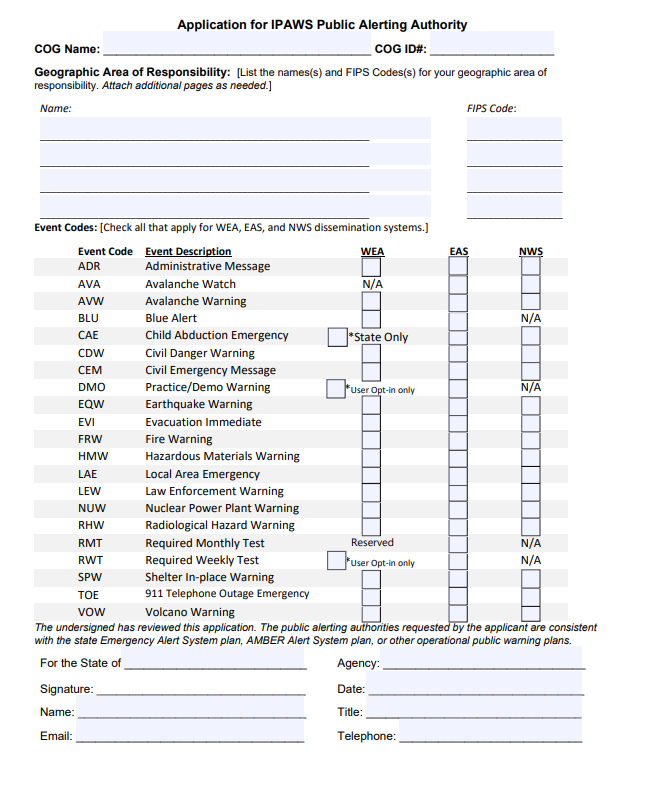Access IPAWS: Apply Now!
Federal agencies and state, local, tribal, and territorial governments are eligible to send alerts using IPAWS. This article will explain how to apply for access to IPAWS.
A federal, state, local, tribal or territorial alerting authority that applies for authorization to use the Integrated Public Alert and Warning System (IPAWS) is designated as a Collaborative Operating Group or “COG.” There are currently numerous types of COGs affiliated with IPAWS varying in size, structure and governance styles. A COG may have members from multiple jurisdictions with each individual member account administered through its software system.
Before beginning the below process, consult with your State IPAWS representative, typically found in the State Emergency Management Agency, for your ability to become an IPAWS alerting authority.
Step #1 – Complete IPAWS Web-Based Training
FEMA’s Emergency Management Institute (EMI) offers the independent study course, IS-247 Integrated Public Alert and Warning System for Alert Originators.
The goal of the course is to provide authorized public safety officials with:
- Increased awareness of the benefits of using IPAWS for effective alerts and warnings
- Improved skills to draft more appropriate, effective, and accessible alert and warning messages
- Increased understanding of the importance of training, testing and exercising with IPAWS
- Best practices in the effective use of IPAWS to reach members of the public
The course should take approximately two hours to complete and is a prerequisite for full access to IPAWS-OPEN for the purpose of public alerting. FEMA does not provide training on third-party alert origination software. Contact your vendor for any software support questions.
Additionally, EMI offers the optional course, IS-251 Integrated Public Alert and Warning System for Alerting Administrators.
The goal of the course is to provide authorized alerting administrators guidance with:
- Developing effective policies, plans and procedures
- Defining the approval process
- Defining the importance of training, practice and exercising with IPAWS
- Illustrating best practices and effective use of IPAWS to reach members of the public
Step #2 – Select IPAWS Compatible Software
Access to IPAWS is free. To send a message using IPAWS, however, an organization must procure its own IPAWS-compatible software. Software should be successfully tested in the IPAWS Open Platform for Emergency Networks (IPAWS-OPEN) test environment and should meet the critical capabilities recommended by FEMA. Consult with your software developer to ensure your system is IPAWS-OPEN compatible and provides the capabilities that your organization requires.
Software Providers and Developers
See FEMA's lists of private-sector providers who have executed a Memorandum of Agreement (MOA) with IPAWS and have successfully demonstrated their IPAWS capabilities. AlertSense/Konexus is an approved IPAWS Provider and was the first to demonstrate successful alert creation and sending to IPAWS-OPEN.
To become a COG, a Memorandum of Agreement (MOA) must be executed between the sponsoring organization and FEMA. The MOA governs interoperability and security across emergency response organizations and systems. Each MOA is tailored to the sponsoring organization and their interoperable software system. Fill out the form on the IPAWS Portal. Login information will be sent to you to create your application. Please refer to the Page 2 document linked below for some information that is needed on the application specific to AlertSense/Konexus.
Once the complete MOA Application has been received by IPAWS, the Customer Support Branch will prepare the MOA for signature and return it to the sponsoring organization with a COG Identification (ID) number.
Complete the electronic MOA ApplicationDownload Page 2 of the MOA Application with AlertSense/Konexus Information
Make sure to attach a copy of your is247 class as instructed.
Step #4 – Apply for Public Alerting Permissions
Alerting authorities that intend to send alerts to the public through IPAWS must complete an application defining the types of alerts they intend to issue and the extent of their geographic warning area. The application for IPAWS public alerting authority will be provided when you apply for a COG MOA, along with contact information for a designated state reviewer. In order to ensure consistency with state, tribal and territorial public alerting plans, the application must be reviewed and signed by a designated state official or tribal leadership before it is submitted to FEMA.
This application is sent to the contacts listed on the MOA after it is signed by FEMA. This form allows the agency to designate what types of alerts they will be sending and through what channels. Once it is signed by your State representative, if applicable, it is returned to FEMA. This is the final step before a COG approval.
What to Expect
A copy of the executed MOA will be returned to the sponsoring organization along with a digital certificate that is needed to configure the IPAWS compatible software system. By completing steps one through three, the organization will have the capability to exchange messages and content between COGs, but is not yet able to alert the public via IPAWS.
Once the public alerting application is received, specific alerting permissions will be implemented in IPAWS-OPEN. At that point the individual members, specified by the COG, will be able to send public alerts and warnings in their geographically prescribed areas.
Initial functionality includes the ability to access and send alerts through:
- Emergency Alert System (EAS)
- Wireless Emergency Alerts (WEA), depending on local implementation by commercial mobile service providers
- NOAA Weather Radio (NWEM)
- Internet-Based Services and Unique Systems
The process for obtaining a COG can take anywhere from 3-12 months.
